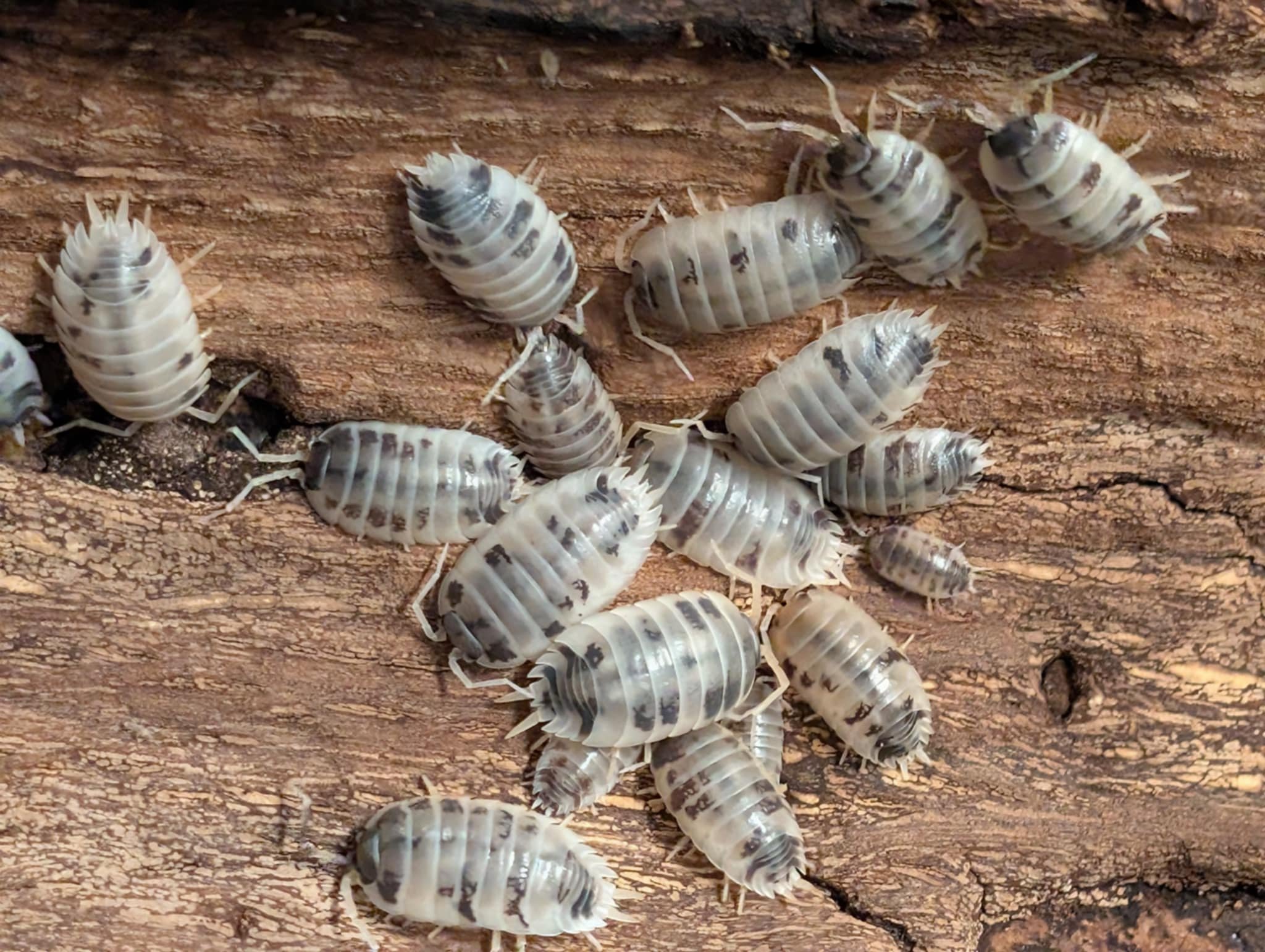
Dairy Cow
20 Count Per Culture
The Dairy Cow Isopod (Porcellio laevis) is a popular and relatively easy-to-care-for species, making it a great choice for both beginners and experienced isopod keepers. Here's a rundown of their key characteristics:
Appearance:
Size: They are a medium-sized isopod, reaching about 1-2 centimeters (0.4-0.8 inches) in length.
Coloration: They have a distinctive black and white coloration, resembling the pattern of a dairy cow. The black base color is accented with white or cream-colored patches or stripes.
Shape: They have an oval-shaped, segmented body, typical of Porcellio isopods.
Habitat and Care:
Origin: Porcellio laevis is a widespread species, found in many parts of the world. The "Dairy Cow" variety is a selectively bred morph.
Environment: They prefer warm, humid environments with good ventilation.
Temperature: They thrive in temperatures between 70-85°F (21-29°C).
Humidity: High humidity is essential for their well-being, ideally around 60-80%.
Substrate: A mix of damp soil, leaf litter, decaying wood, and sphagnum moss provides an ideal substrate.
Enclosure: A well-ventilated container with plenty of hiding places (cork bark, leaf litter, etc.) is necessary.
Other Characteristics:
Temperament: They are generally peaceful and easy to handle, though they prefer to stay hidden.
Breeding: They breed readily in captivity, with females carrying the eggs in a brood pouch until they hatch.
Lifespan: They can live for several years with proper care.
Bioactive Clean-up Crew: They are a popular choice for bioactive terrariums, where they help break down organic waste and contribute to a healthy ecosystem.
Important Notes:
Humidity: Maintaining proper humidity is crucial for their health. Insufficient humidity can lead to molting problems and even death.
Ventilation: While they need high humidity, they also require good ventilation to prevent the growth of mold and mildew.
Diet: They are detritivores, feeding on decaying organic matter, leaf litter, and wood. They also benefit from supplemental feeding with fruits, vegetables, and protein sources like fish flakes or dried shrimp.
Dairy Cow
20 Count Per Culture
The Dairy Cow Isopod (Porcellio laevis) is a popular and relatively easy-to-care-for species, making it a great choice for both beginners and experienced isopod keepers. Here's a rundown of their key characteristics:
Appearance:
Size: They are a medium-sized isopod, reaching about 1-2 centimeters (0.4-0.8 inches) in length.
Coloration: They have a distinctive black and white coloration, resembling the pattern of a dairy cow. The black base color is accented with white or cream-colored patches or stripes.
Shape: They have an oval-shaped, segmented body, typical of Porcellio isopods.
Habitat and Care:
Origin: Porcellio laevis is a widespread species, found in many parts of the world. The "Dairy Cow" variety is a selectively bred morph.
Environment: They prefer warm, humid environments with good ventilation.
Temperature: They thrive in temperatures between 70-85°F (21-29°C).
Humidity: High humidity is essential for their well-being, ideally around 60-80%.
Substrate: A mix of damp soil, leaf litter, decaying wood, and sphagnum moss provides an ideal substrate.
Enclosure: A well-ventilated container with plenty of hiding places (cork bark, leaf litter, etc.) is necessary.
Other Characteristics:
Temperament: They are generally peaceful and easy to handle, though they prefer to stay hidden.
Breeding: They breed readily in captivity, with females carrying the eggs in a brood pouch until they hatch.
Lifespan: They can live for several years with proper care.
Bioactive Clean-up Crew: They are a popular choice for bioactive terrariums, where they help break down organic waste and contribute to a healthy ecosystem.
Important Notes:
Humidity: Maintaining proper humidity is crucial for their health. Insufficient humidity can lead to molting problems and even death.
Ventilation: While they need high humidity, they also require good ventilation to prevent the growth of mold and mildew.
Diet: They are detritivores, feeding on decaying organic matter, leaf litter, and wood. They also benefit from supplemental feeding with fruits, vegetables, and protein sources like fish flakes or dried shrimp.
